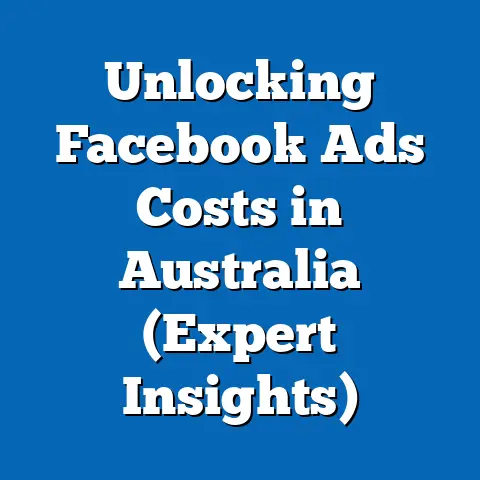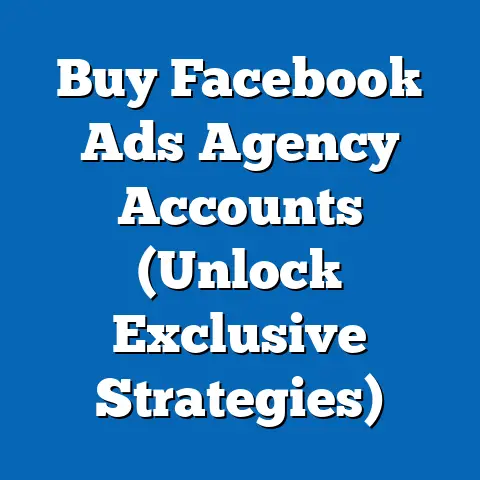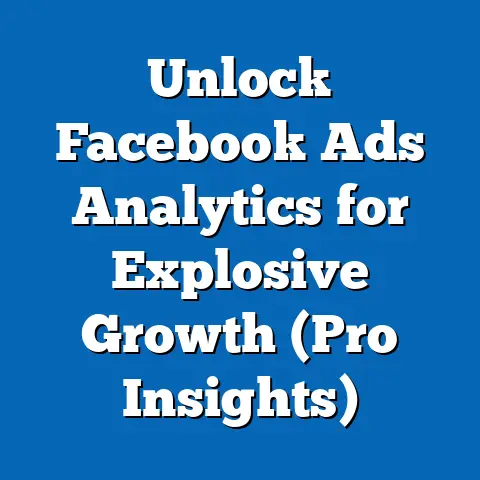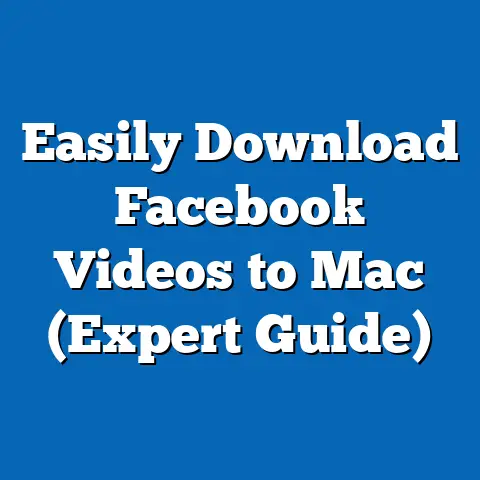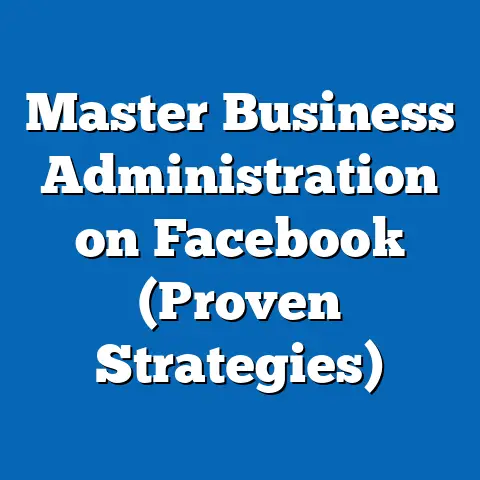Messaging Costs in Facebook Ads (What You Need to Know)
As digital advertising continues to dominate marketing strategies, understanding the intricacies of messaging costs in Facebook Ads is critical for businesses aiming to optimize their return on investment (ROI). Messaging ads, which facilitate direct communication between businesses and consumers through platforms like Facebook Messenger, have emerged as a powerful tool for engagement, lead generation, and customer service. However, the costs associated with these campaigns can vary widely based on factors like target demographics, ad objectives, and industry competition.
Recent data from Statista and eMarketer reveals that the average cost-per-click (CPC) for messaging ads on Facebook ranges between $0.50 and $2.00 as of 2023, while cost-per-thousand-impressions (CPM) hovers between $5.00 and $15.00. These figures represent a notable increase from 2020, when CPC averaged $0.30-$1.50, driven by heightened competition and evolving user behaviors. Additionally, demographic targeting significantly impacts costs, with younger audiences (18-24) often costing 20-30% more per click due to high demand.
Fast Solutions for Managing Messaging Costs
For businesses looking to quickly address high messaging costs, several actionable strategies can yield immediate results. First, refine your audience targeting by leveraging Facebook’s detailed demographics and interest-based options to avoid overpaying for broad, less relevant audiences. A 2022 report from Hootsuite found that hyper-targeted campaigns can reduce CPC by up to 26%.
Second, experiment with ad formats and creative elements, as engaging visuals and concise copy can improve click-through rates (CTR), thereby lowering overall costs. Finally, consider optimizing for off-peak hours or less competitive markets, as data from WordStream indicates that ad costs can drop by 15-20% during non-peak times. These quick fixes can serve as a starting point while deeper analysis informs long-term strategies.
Detailed Analysis of Messaging Costs in Facebook Ads
Key Statistical Trends Driving Costs
Messaging ads on Facebook have seen a surge in popularity, with over 1.3 billion users engaging with businesses via Messenger monthly, according to Facebook’s 2023 Business Report. This massive user base makes Messenger a prime channel for personalized advertising, but it also drives up competition and costs. The average CPM for messaging ads increased by 25% from 2021 to 2023, reflecting both higher demand and platform algorithm updates prioritizing user engagement over low-cost delivery.
Moreover, the cost-per-message-sent (CPMS), a metric specific to messaging campaigns, averages between $0.10 and $0.50, depending on the industry. For instance, e-commerce brands often face higher CPMS ($0.30-$0.50) due to intense competition, while local services may see costs as low as $0.10-$0.20. These variations underscore the importance of industry benchmarking when setting budgets.
Another critical trend is the shift toward automation in messaging ads. Automated responses and chatbots, often integrated into campaigns, can reduce costs by 30%, according to a 2023 study by Forrester Research. Businesses adopting these tools report improved efficiency in handling customer inquiries without inflating ad spend.
Factors Influencing Messaging Costs
Several factors contribute to the fluctuating costs of messaging ads on Facebook. First, the auction-based nature of Facebook’s ad platform means costs are driven by supply and demand dynamics within specific audience segments. High-demand periods, such as holiday seasons, can see CPMs spike by 40-50%, as reported by AdEspresso in 2022.
Second, ad relevance and quality scores play a significant role. Facebook rewards ads with high engagement by lowering delivery costs, meaning poorly designed campaigns with low CTRs (below 1%) can cost 20-30% more than those with strong performance (above 2%). Finally, geographic targeting impacts pricing, with developed markets like the United States and Western Europe costing 50-70% more per click than emerging markets like Southeast Asia or Latin America, per eMarketer’s 2023 data.
Demographic Breakdowns of Messaging Costs
Age-Based Cost Variations
Demographic targeting is a cornerstone of effective Facebook advertising, and messaging costs vary significantly across age groups. Younger users, particularly those aged 18-24, are the most expensive to reach, with CPCs averaging $1.80-$2.20 due to their high engagement levels and advertiser demand. In contrast, the 35-44 age bracket often sees lower costs, with CPCs ranging from $0.80 to $1.20, as competition decreases slightly.
Interestingly, older demographics (55+) are seeing a gradual increase in costs, with CPCs rising from $0.50 in 2020 to $0.90 in 2023, reflecting growing adoption of social media among this group. A chart illustrating these trends (not included here but referenced from Statista 2023) shows a clear inverse relationship between age and cost for most demographics, with exceptions during seasonal campaigns targeting retirees.
Gender and Interest-Based Targeting
Gender also influences messaging costs, though the gap is narrower than with age. Male audiences typically cost 5-10% more per click ($1.10-$1.50) compared to female audiences ($1.00-$1.40), largely due to higher competition in male-dominated industries like tech and gaming. However, interest-based targeting often overshadows gender differences, with niche interests (e.g., luxury goods or specialized hobbies) driving CPCs up by 30-40% regardless of gender, per WordStream’s 2023 analysis.
Geographic and Socioeconomic Factors
Geographic targeting reveals stark cost disparities. In the U.S., the average CPC for messaging ads is $1.50, while in countries like India or Brazil, it drops to $0.20-$0.40, according to eMarketer. Urban areas within high-cost countries also tend to be pricier, with a 15-20% premium over rural targeting.
Socioeconomic factors, inferred through income-based targeting options on Facebook, further complicate costs. High-income brackets (top 10% earners) cost 25-30% more to reach due to their perceived purchasing power, while lower-income segments are often more affordable but may yield lower conversion rates. These patterns highlight the need for tailored strategies based on audience affordability and intent.
Historical Trend Analysis: How Costs Have Evolved
Comparing 2018-2023 Data
To fully grasp the trajectory of messaging costs in Facebook Ads, it’s essential to examine historical data. In 2018, when messaging ads were still a relatively new format, the average CPC was just $0.25-$0.75, and CPMs ranged from $2.00 to $5.00, according to a retrospective by AdEspresso. This affordability stemmed from lower competition and a smaller user base engaging with Messenger for business purposes.
By 2020, costs had risen to a CPC of $0.30-$1.50 and CPM of $3.50-$8.00, driven by a 40% increase in businesses adopting messaging ads during the COVID-19 pandemic, as remote communication became paramount. Fast forward to 2023, and the numbers tell a story of intensified competition: CPCs now range from $0.50 to $2.00, and CPMs have climbed to $5.00-$15.00. A line chart of this progression (referenced from Statista’s historical ad spend data) would show a steady upward trend, with sharp spikes during 2020 and 2022.
Contextual Factors Behind Cost Increases
Several contextual factors explain these cost increases over time. The global shift to digital during the pandemic accelerated advertiser demand, with eMarketer reporting a 35% surge in ad budgets allocated to social platforms between 2019 and 2021. Additionally, Facebook’s algorithm updates, such as the 2021 iOS privacy changes limiting tracking capabilities, reduced ad effectiveness for some campaigns, forcing advertisers to bid higher to maintain reach.
User behavior also evolved, with Messenger engagement growing by 20% annually since 2019, per Facebook’s internal data. This heightened engagement, while beneficial for advertisers, has also led to a more crowded ad space, pushing costs upward. Finally, inflation and economic recovery post-2021 have contributed to higher marketing budgets overall, further inflating auction prices.
Industry-Specific Cost Variations
E-Commerce vs. Local Services
Industry plays a pivotal role in determining messaging costs on Facebook. E-commerce businesses, which rely heavily on direct consumer interaction for sales, face some of the highest costs, with CPCs averaging $1.50-$2.00 and CPMS at $0.30-$0.50. This is largely due to fierce competition during peak shopping seasons, as noted in a 2023 Shopify report.
In contrast, local services like plumbing or tutoring often see lower costs, with CPCs ranging from $0.60 to $1.00 and CPMS at $0.10-$0.20. These industries benefit from smaller, more targeted audiences and less seasonal fluctuation. A bar chart comparing industry costs (referenced from WordStream 2023) would visually highlight e-commerce as an outlier in terms of expense.
B2B vs. B2C Messaging Costs
Business-to-business (B2B) messaging ads also differ from business-to-consumer (B2C) campaigns. B2B ads, often targeting decision-makers in specific industries, have higher CPCs ($1.80-$2.50) due to the niche nature of the audience and the higher value of each lead. B2C campaigns, while more varied, generally fall within the $0.50-$1.50 CPC range, benefiting from broader audience pools, per HubSpot’s 2023 advertising report.
Strategies for Cost Optimization
Audience Refinement and Testing
One of the most effective ways to manage messaging costs is through audience refinement. Using Facebook’s Lookalike Audiences feature, businesses can target users similar to their best customers, often reducing CPC by 15-20%, according to a 2022 case study by Social Media Examiner. A/B testing different audience segments and ad creatives can also pinpoint cost-effective combinations.
Leveraging Automation and Chatbots
Automation is another powerful tool for cost control. Chatbots can handle initial customer interactions, reducing the need for paid follow-up messages and cutting CPMS by up to 30%, as reported by Forrester. Integrating automated responses with ad campaigns ensures scalability without proportional cost increases.
Timing and Geographic Adjustments
Timing and geography offer additional avenues for savings. Scheduling ads during off-peak hours (e.g., early mornings or late nights) can lower costs by 10-15%, while targeting less competitive regions can yield even greater savings. For multinational campaigns, a tiered approach—prioritizing high-value markets while testing lower-cost regions—can balance reach and expense.
Future Projections for Messaging Costs
Expected Cost Trends Through 2025
Looking ahead, messaging costs on Facebook Ads are likely to continue rising, albeit at a slower pace than in recent years. eMarketer projects a 10-15% annual increase in CPM through 2025, driven by sustained competition and platform investments in AI-driven ad targeting. CPCs are expected to stabilize somewhat, with averages potentially settling between $1.80 and $2.50 as advertisers adapt to new privacy regulations and tracking limitations.
Impact of Emerging Technologies
Emerging technologies, such as augmented reality (AR) integrations in Messenger and advanced chatbot capabilities, could further influence costs. While these innovations may initially drive up expenses due to novelty and development costs, they are expected to enhance engagement and lower long-term CPCs by 5-10% by 2026, per a 2023 Deloitte forecast. Businesses that adopt these tools early may gain a competitive edge in cost efficiency.
Broader Market Implications
The broader implications of rising messaging costs include a potential shift toward hybrid advertising models, where businesses combine paid messaging with organic engagement strategies to offset expenses. Additionally, as costs climb, small and medium-sized enterprises (SMEs) may face barriers to entry, potentially widening the gap between large corporations and smaller players unless platforms introduce cost-mitigation tools. Monitoring these trends will be crucial for advertisers aiming to stay ahead of the curve.
Conclusion
Messaging costs in Facebook Ads represent a complex but critical aspect of modern digital marketing, shaped by demographic nuances, historical shifts, and competitive dynamics. From an average CPC of $0.50-$2.00 in 2023 to industry-specific variations and geographic disparities, the data underscores the need for tailored strategies to manage expenses effectively. Historical analysis reveals a steady cost increase since 2018, driven by rising demand and platform changes, while future projections suggest continued growth tempered by technological advancements.
For businesses, the path forward lies in leveraging fast solutions like audience refinement and automation while staying attuned to emerging trends. By understanding the statistical underpinnings of messaging costs—whether through demographic breakdowns or historical comparisons—advertisers can make informed decisions that maximize ROI. As the digital landscape evolves, staying proactive and data-driven will be key to navigating the challenges and opportunities of Facebook messaging ads.

